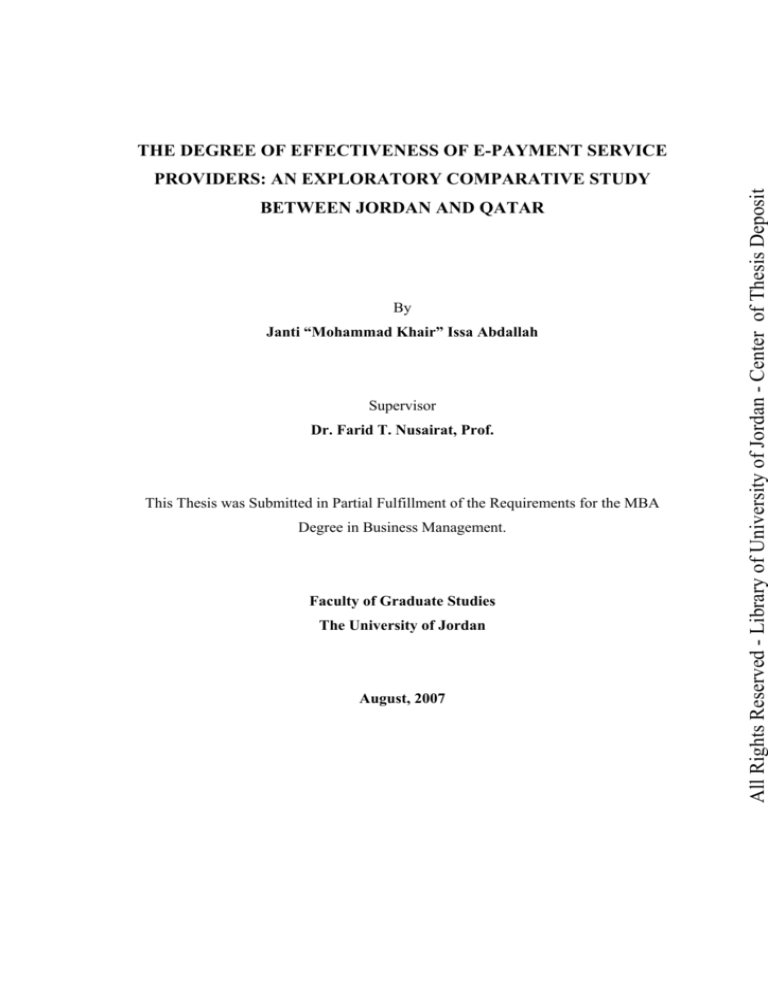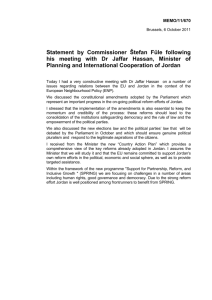
THE DEGREE OF EFFECTIVENESS OF E-PAYMENT SERVICE
BETWEEN JORDAN AND QATAR
By
Janti “Mohammad Khair” Issa Abdallah
Supervisor
Dr. Farid T. Nusairat, Prof.
This Thesis was Submitted in Partial Fulfillment of the Requirements for the MBA
Degree in Business Management.
Faculty of Graduate Studies
The University of Jordan
August, 2007
All Rights Reserved - Library of University of Jordan - Center of Thesis Deposit
PROVIDERS: AN EXPLORATORY COMPARATIVE STUDY
ii
This Thesis (The Degree of Effectiveness of E-Payment Service Providers: An
Exploratory Comparative Study between Jordan and Qatar) was successfully
defended and approved on 1st Aug, 2007.
Examination Committee
Signature
Dr. Farid T. Nusairat, Chairman
Professor, Business Administration
------------------------------
Dr. Ribhi M. I. El-Hasan, Member
Associate Professor, Public Administration
------------------------------
Dr. Idries M. Al-Jarrah, Member
Assistant Professor, Finance
------------------------------
Dr. Adel Al-Rasheed, Member
Professor, Business Administration
(Yarmouk University)
------------------------------
All Rights Reserved - Library of University of Jordan - Center of Thesis Deposit
Committee Decision
iii
Dedication
To my wife, who took care of my responsibilities in addition to hers, and patiently
supported me every time I was close to giving up.
To my little daughter Tala, who adds color to my life.
All Rights Reserved - Library of University of Jordan - Center of Thesis Deposit
To my parents, who taught me how to have great expectations.
iv
Acknowledgement
Nusairat, for his support, guidance, encouragement and feedback, which substantially
helped me achieve this work.
I would also like to thank the reputable committee members for discussing this thesis
and enriching it with their valuable comments.
All Rights Reserved - Library of University of Jordan - Center of Thesis Deposit
I would like to extend my special thanks and gratitude to my supervisor; Dr. Farid
v
List of Contents
Page
Committee Decision ........................................................................................................ ii
Dedication....................................................................................................................... iii
Acknowledgement .......................................................................................................... iv
List of Contents.................................................................................................................v
List of Tables .................................................................................................................. vi
List of Figures................................................................................................................ vii
List of Abbreviations or Symbols................................................................................. viii
ABSTRACT.................................................................................................................... ix
Chapter 1: General Framework.........................................................................................1
Introduction ................................................................................................................... 1
Research Problem.......................................................................................................... 5
Importance of the Study ................................................................................................ 5
Research Objectives ...................................................................................................... 7
Research Limitations ..................................................................................................... 8
Study Design and Methodology .................................................................................... 9
Variables...................................................................................................................... 13
Chapter 2: Theoretical Framework .................................................................................16
Literature Review ........................................................................................................ 16
Venturing into e-Payments Processing: Background on Studied Organizations ........ 20
Chapter 3: Data Analysis, Results and Discussion .........................................................34
Data Analysis and Results ........................................................................................... 34
Discussion.................................................................................................................... 51
Conclusions ................................................................................................................. 54
Recommendations ....................................................................................................... 55
REFERENCES ...............................................................................................................56
Appendix 1: Observer Questions on Structuring Characteristics ...................................59
Appendix 2: Suggested Customer Survey ......................................................................61
Abstract in Arabic Language ..........................................................................................63
All Rights Reserved - Library of University of Jordan - Center of Thesis Deposit
Subject
vi
List of Tables
Title
Page
Table 1: Studies examining structuring elements vs. organizational effectiveness........ 18
Table 2: Scores on strategies for managing organizational interdependence ................. 35
Table 3: Scores on organizational structuring elements rated by four observers ........... 36
Table 4: Organizational effectiveness, paired ranking ................................................... 47
All Rights Reserved - Library of University of Jordan - Center of Thesis Deposit
No.
vii
List of Figures
Title
Page
Figure 1: The layout of players participating in an e-payment cycle ............................... 2
Figure 2: Theoretical model for the organization/ environment fit ................................ 13
Figure 3: Internal and external corporate level growth strategies .................................. 20
Figure 4: QCB's expansion perspective .......................................................................... 24
Figure 5: QCB's strategy to manage symbiotic interdependence ................................... 25
Figure 6: QCB's strategy to manage competitive interdependence ................................ 26
Figure 7: PAYNET’s strategy for managing symbiotic interdependence ...................... 29
Figure 8: VJCS expansion perspective ........................................................................... 30
Figure 9: STS expansion perspective.............................................................................. 31
Figure 10: PAYNET’s strategy for managing competitive interdependence ................. 33
Figure 11: Organizational Effectiveness Comparison Results (14-point scale) ............. 48
All Rights Reserved - Library of University of Jordan - Center of Thesis Deposit
No.
viii
BIS
Bank for International Settlement
IT
Information Technology
PSP
Payment Service Provider
STS
Specialized Technical Services Co.
VJCS
Visa Jordan Card Services Co.
QCB
Qatar Central Bank
All Rights Reserved - Library of University of Jordan - Center of Thesis Deposit
List of Abbreviations or Symbols
ix
By
Janti “Mohammad Khair” Issa Abdallah
Supervisor
Dr. Farid T. Nusairat, Prof.
ABSTRACT
This study addressed the fit between the new venture organization and its environment.
It aimed at identifying the organizational design factors that effect the degree of its
effectiveness, in addition to formulating a set of hypotheses about the relationship
between such factors and the degree of effectiveness of ePayment Service Providers
(PSPs) in the Arab countries, through making a comparison between two of such PSPs
operating in this sector that can be described as a highly uncertain environment.
The research population included two corresponding organizations that were considered
to be the national payment gateways in their respective countries; Jordan and Qatar.
Three middle managers working at the supplier of the two organizations where surveyed
as observers. Observation was used to collect data, with minimal dependence on
perceptions and personal opinions and using more reliable sources like company records
and official statistics instead. The most effective organization was hence identified, and
its organizational design was accordingly inspected and highlighted as a potential best
fit for the requirements of its environment.
Relevant hypothetical relationships between organizational design and organizational
effectiveness were then formulated and proposed for extensive future research.
All Rights Reserved - Library of University of Jordan - Center of Thesis Deposit
FACTORS AFFECTING THE DEGREE OF EFFECTIVENESS OF
E-PAYMENT SERVICE PROVIDERS: AN EXPLRATORY
COMPARATIVE STUDY BETWEEN JORDAN AND QATAR
1
Chapter 1: General Framework
The provision of Electronic Payment Processing Services is a relatively new concept for
the Arab countries, compared to other regions like North America and Europe. Many
business and government entities (referred to as “Merchants”) are recently becoming
more interested in accepting electronic payments across several channels (e.g. Internet,
ATM, etc.) in return for the products and services they provide. Accordingly, different
kinds of organizations began to offer payment processing services in countries like
Saudi Arabia, Jordan, Bahrain, Egypt and Qatar to enable merchants to accept electronic
payments.
Figure 1 illustrates a common relevant setting for multiple players participating in an
electronic purchase (or payment) cycle. An e-Payment Processor (PP) acts as a central
point of dealership between several merchants (accepting electronic payment in
exchange to the e-commerce, e-billing or e-government products and services they
provide) from one side, and several acquiring banks at the other side. A customer
(payer) uses the Internet to visit the merchant website (or portal) aiming at purchasing a
product/ service or settling a bill. The payment processor consolidates the services of
multiple acquirers, and hence provides merchants with several payment acceptance
options.
All Rights Reserved - Library of University of Jordan - Center of Thesis Deposit
Introduction
Figure 1: The layout of players participating in an e-payment cycle
The acquiring bank (also known as "the acquirer') is the entity that holds deposit
accounts for merchants (also called payees or "card acceptors") and to which the card
acceptor transmits the data relating to the transaction (possibly through the processor).
The acquirer is responsible for the collection of transaction information and settlement
with the acceptors (BIS, 2003).
The issuing bank (also called "the issuer") undertakes responsibility to settle
transactions made with the card used by its customers with the acquiring bank, through
the financial network (e.g. Visa or MasterCard).
A typical service usage scenario starts when customers visit the website of the merchant
and decide to buy a product or a service or settle a bill. Upon viewing the corresponding
order details on the website (e.g. price, shipping information, etc.), customers then
choose their preferred instrument (method) of payment (e.g. credit cards, bank account,
prepaid mobile phone balance, etc.) and provide the necessary information (e.g. credit
card number, expiry date, etc.) and confirm that they authorize their credit card, debit
card or bank account be debited against a certain amount. The payment transaction is
authorized by the corresponding issuing bank (through the path shown in Figure 1) and
the delivery of the purchased product or service accordingly commences.
All Rights Reserved - Library of University of Jordan - Center of Thesis Deposit
2
3
Payment Processors (PPs) –the focus of this study- can have two types of customers
from whom they generate their revenues directly or indirectly: merchants and acquiring
payment processing infrastructure consisting of hardware (e.g. computers, servers) and
specialized software as well as connectivity and integration to other technical
infrastructures (those of merchants and acquirers, mainly). As the case may be, the PP
may charge the relevant merchant and/or acquirer with a fixed recurring membership
fee (e.g. monthly or annual subscription) plus a certain fee per processed transaction.
A PP also invests in hiring and training a specialized marketing team that is responsible
for recruiting merchants or “onboarding” them on the service, in addition to making
arrangements for a solid software development team that is capable of performing the
necessary integration tasks between the PP technical infrastructure and those of
acquirers and merchants.
In exchange for the fees charged by a PP, it adds value to its customers by acting as a
central hub which acquirers and merchants can leverage. The presence of this central
entity saves the acquirer from investing in a specialized infrastructure and separately
dealing with each new merchant (for promotion and technical integration). The presence
of this central entity also saves the merchant from connecting to several acquirers
independently. It is also not uncommon for a PP to facilitate the agreement among its
affiliate acquirers in regards to unifying their service level agreements (contracts) that
are signed with the merchants (including the fee structure).
A good chuck of the day-to-day work of a PP (after merchants are successfully
onboarded) can be classified into what Woodward (1958) defined as continuous-process
technology. Within this category, employees of the organization are usually not
involved in converting the input to output (called the conversion process). Instead,
employees monitor the process and only handle exceptions like machine breakdown or
system malfunction. And so, “production” smoothly continues and rarely stops. The
PP’s software automatically processes payment requests generated by the merchant
All Rights Reserved - Library of University of Jordan - Center of Thesis Deposit
banks. A payment processor mainly makes a substantial investment in a technical
4
website (input) and authorization results originally generated by the issuer system and
received by the PP through the acquirer (output), as illustrated in Figure 1.
design aspects; and they deal with their generic and specific environments to achieve
certain goals. Payment processors were the locus of attention of this study, which
attempted to isolate the organizational design factors affecting their effectiveness and
pave the way for consecutive studies to test corresponding hypotheses.
Two PPs were chosen to be thoroughly studied as a form of a PSP; “PAYNET” the
national payment gateway in Jordan and “Q-PAY” the national payment gateway in
Qatar. At the time this study was conducted, the studied organizations were neither
entirely new ventures, nor mature organizations. This is because many payment
processing services are introduced by newly established business units that are
operating within existing and mature organizations. Yet, the studied organizations were
considered to be “new” since they are within their first five years of existence (Sine et
al, 2006).
The studied organizations used the same technology and were customers of the same IT
supplier (Specialized Technical services “STS”), who provided them with the necessary
technical infrastructure (a specialized enterprise software solution called “PayONE™”)
to establish their services. Yet, each PP customized the application of the solution in
line with its directions.
In addition, each of parent organizations behind PAYNET and Q-PAY (Visa Jordan
Card Services “VJCS” in Jordan and Qatar Central Bank “QCB” in Qatar) chose a
different integration mechanism with the supplier (STS) and service distributors. For
example, in Jordan, VJCS (a financial services company, owned by ten commercial
Jordanian banks and Visa International) established a joint venture with STS to co-own
and operate “PAYNET”, while in Qatar, QCB (a government entity) chose to purchase
the system from STS, and became the sole owner of “Q-PAY”.
All Rights Reserved - Library of University of Jordan - Center of Thesis Deposit
Like other types of organizations, payment processors have different organizational
5
Research Problem
Classical academic theories were introduced by distinguished researchers and scholars
organizations operate. This study leveraged such theories and aimed at applying them
on organizations operating in a relatively new industry; electronic payment processing
service provision in a new region (i.e. the Arab countries), by comparing two
organizations acting as PPs; which are “PAYNET” in Jordan, and “Q-PAY” in Qatar.
While Burns and Stalker (1961) argued that organizations with organic structures, or
loosely coupled networks of workers, are better adapted to dynamic environments,
recent studies argued that this is not true for small, new organizations in turbulent,
emerging economic sectors (Sine et al., 2006).
There were similarities and differences between the two studied organizations, and
having the researcher closely observing the two models as an employee in STS,
questions were raised regarding what factors in terms of organizational design could
contribute to –or stand against- the success of a PSP in an Arab country, considering the
nature of the environment it operates in.
Importance of the Study
It is important to note that, many scholars and researchers previously applied the
“organization-environment fit” theoretical framework similar to the one used in this
study (originally formulated by Burns and Stalker) and conducted their studies in
several industries in different areas of the world. What is interesting in this context is
that, the findings of many of these studies where various and sometimes contradicting,
although they all used similar –if not identical- theoretical frameworks (Dalton et al.,
1980). This means that different findings can be reached in different industries or
regions, and generalization in this case would hence not be applicable to a great extent.
This leads us to believe that opening the door for applying the “organizationenvironment fit” theoretical framework and testing for corresponding hypotheses in the
All Rights Reserved - Library of University of Jordan - Center of Thesis Deposit
examining the “fit” between the organizational design and the environment in which
6
payment service provision industry in the Arab countries is highly needed, since it may
generate new findings that could be unique to this industry in this part of the world.
researches considered the payment service provision industry, nor the Arab countries,
and hence, relevant literature was found to be very scarce. Obviously, conducting indepth studies in this area needs elaborate relevant information to be gathered to act as a
starting point, and this is where this study adds value.
Another distinguishing factor of this study is that it extended the traditional
organization-environment fit theoretical model adopted by all of the examined studies
by adding two other dimensions to the organizational design variable: strategies for
managing symbiotic resource interdependencies and strategies for managing
competitive resource interdependencies.
On the practical aspect, this research may provide regionally-tailored guidelines for
organizations that wish to enter the PSP business in Arab countries. Such organizations
should pay attention to certain organizational design factors that can help them achieve
better effectiveness. The researcher blended his subject-matter expertise in the
electronic payment services domain with the academic background acquired throughout
being an MBA student at the University of Jordan in an attempt to achieve unique
contribution to the literature.
All Rights Reserved - Library of University of Jordan - Center of Thesis Deposit
Moreover, it was found out that seldom -or even none- of the above mentioned
61
Appendix 2: Suggested Customer Survey
أواﻓﻖ
أواﻓﻖ
ﻣﺤﺎﻳﺪ
ﻻ أواﻓﻖ
All Rights Reserved - Library of University of Jordan - Center of Thesis Deposit
ﺑﺸﺪة
ﻻ
أواﻓﻖ
ﺑﺸﺪة
.١ﻗﺎﻣﺖ )اﻟﻤﺆﺳﺴﺔ( ﺑﺎﻟﻤﺒﺎدرة ﺑﻤﺨﺎﻃﺒﺘﻨﺎ ﻟﻼﺳﺘﻔﺎدة ﻣﻦ
ﺧﺪﻣﺎت اﻟﺪﻓﻊ اﻻﻟﻜﺘﺮوﻧﻲ
□١
□٢
□٣
□٤
□٥
.٢ﻗﺎﻣﺖ ﻣﺆﺳﺴﺘﻲ ﺑﺎﺳﺘﺪراج ﻋﺮوض ﻣﻦ ﻋﺪة ﻣﺰودﻳﻦ
ﻟﺨﺪﻣﺎت اﻟﺪﻓﻊ اﻻﻟﻜﺘﺮوﻧﻲ
□١
□٢
□٣
□٤
□٥
.٣ﻟﺪي ﻣﻌﺮﻓﺔ آﺎﻓﻴﺔ ﺑﻜﻴﻔﻴﺔ وﻣﺘﻄﻠﺒﺎت اﻻﺷﺘﺮاك ﻓﻲ
ﺧﺪﻣﺔ اﻟﺪﻓﻊ اﻹﻟﻜﺘﺮوﻧﻲ اﻟﻤﻘﺪﻣﺔ ﻣﻦ ﻗﺒﻞ )اﻟﻤﺆﺳﺴﺔ(
□١
□٢
□٣
□٤
□٥
.٤ﻣﻦ اﻟﺴﻬﻞ اﻟﺤﺼﻮل ﻋﻠﻰ اﻟﻤﻌﻠﻮﻣﺎت اﻟﻜﺎﻣﻠﺔ ﻋﻦ
ﻣﺘﻄﻠﺒﺎت اﻻﺷﺘﺮاك ﻓﻲ ﺧﺪﻣﺔ اﻟﺪﻓﻊ اﻹﻟﻜﺘﺮوﻧﻲ
اﻟﻤﻘﺪﻣﺔ ﻣﻦ ﻗﺒﻞ )اﻟﻤﺆﺳﺴﺔ(
□١
□٢
□٣
□٤
□٥
.٥اﻟﻤﺘﻄﻠﺒﺎت اﻹدارﻳﺔ واﻟﻘﺎﻧﻮﻧﻴﺔ ﻟﻼﺷﺘﺮاك ﻓﻲ ﺧﺪﻣﺔ
اﻟﺪﻓﻊ اﻹﻟﻜﺘﺮوﻧﻲ اﻟﻤﻘﺪﻣﺔ ﻣﻦ ﻗﺒﻞ )اﻟﻤﺆﺳﺴﺔ( ﻣﻨﻄﻘﻴﺔ
وﻣﻘﺒﻮﻟﺔ
□١
□٢
□٣
□٤
□٥
.٦اﻟﻤﺘﻄﻠﺒﺎت اﻟﻔﻨﻴﺔ واﻟﺘﻘﻨﻴﺔ ﻟﻼﺷﺘﺮاك ﻓﻲ ﺧﺪﻣﺔ اﻟﺪﻓﻊ
اﻹﻟﻜﺘﺮوﻧﻲ اﻟﻤﻘﺪﻣﺔ ﻣﻦ ﻗﺒﻞ )اﻟﻤﺆﺳﺴﺔ( ﻣﻨﻄﻘﻴﺔ
وﻣﻘﺒﻮﻟﺔ
□١
□٢
□٣
□٤
□٥
.٧رﺳﻮم اﻻﺷﺘﺮاك ﻓﻲ ﺧﺪﻣﺔ اﻟﺪﻓﻊ اﻹﻟﻜﺘﺮوﻧﻲ اﻟﻤﻘﺪﻣﺔ
ﻣﻦ ﻗﺒﻞ )اﻟﻤﺆﺳﺴﺔ( ﻣﻨﻄﻘﻴﺔ وﻣﻘﺒﻮﻟﺔ
□١
□٢
□٣
□٤
□٥
.٨ﻟﺪﻳﻨﺎ ﻣﻌﺮﻓﺔ آﺎﻓﻴﺔ ﻋﻦ اﻷﺷﺨﺎص واﻟﺠﻬﺎت اﻟﺘﻲ
ﻳﻤﻜﻨﻨﺎ اﻻﺗﺼﺎل ﺑﻬﺎ ﻟﺪى اﺣﺘﻴﺎﺟﻨﺎ ﻟﻤﺴﺎﻋﺪة ﺗﺘﻌﻠﻖ
ﺑﺎﺳﺘﺨﺪاﻣﻨﺎ ﻟﻠﺨﺪﻣﺔ
□١
□٢
□٣
□٤
□٥
.٩ﻳﻘﻮم اﻷﺷﺨﺎص اﻟﻤﺴﺆوﻟﻮن ﻓﻲ )اﻟﻤﺆﺳﺴﺔ( ﺑﺎﻟﺮد
ﻋﻠﻰ اﺳﺘﻔﺴﺎراﺗﻨﺎ وﻃﻠﺒﺎﺗﻨﺎ ﺧﻼل ﻓﺘﺮة زﻣﻨﻴﺔ ﻣﻌﻘﻮﻟﺔ
□١
□٢
□٣
□٤
□٥
.١٠ﺗﻮﻓﺮ )اﻟﻤﺆﺳﺴﺔ( ﻃﺮﻗًﺎ ﻟﻠﺪﻓﻊ اﻹﻟﻜﺘﺮوﻧﻲ ﺗﻤﻜﻨﻨﺎ ﻣﻦ
ﻗﺒﻮل ﺗﺴﺪﻳﺪ اﻟﺘﺰاﻣﺎت ﻏﺎﻟﺒﻴﺔ زﺑﺎﺋﻨﻨﺎ ﻋﺒﺮ هﺬﻩ اﻟﺨﺪﻣﺔ
□١
□٢
□٣
□٤
□٥
.١١ﻻ /ﻟﻦ ﻳﺠﺪ اﻟﻐﺎﻟﺒﻴﺔ ﻣﻦ زﺑﺎﺋﻨﻨﺎ ﺻﻌﻮﺑﺔ ﻓﻲ اﺳﺘﺨﺪام
ﺧﺪﻣﺔ اﻟﺪﻓﻊ اﻹﻟﻜﺘﺮوﻧﻲ اﻟﻤﻘﺪﻣﺔ ﻣﻦ ﻗﺒﻞ )اﻟﻤﺆﺳﺴﺔ(
□١
□٢
□٣
□٤
□٥
.١٢هﻨﺎك ﻧﺴﺒﺔ ﺟﻴﺪة ﻣﻦ زﺑﺎﺋﻨﻨﺎ ﺗﻘﻮم /ﺳﺘﻘﻮم ﺑﺘﺴﺪﻳﺪ
اﻟﺘﺰاﻣﺎﺗﻬﺎ اﻟﻤﺎﻟﻴﺔ ﻟﻨﺎ ﻋﻦ ﻃﺮﻳﻖ اﻟﺨﺪﻣﺔ اﻟﻤﻘﺪﻣﺔ ﻟﻨﺎ
ﻣﻦ ﻗﺒﻞ )اﻟﻤﺆﺳﺴﺔ(
□١
□٢
□٣
□٤
□٥
62
أواﻓﻖ
أواﻓﻖ
ﻣﺤﺎﻳﺪ
ﻻ أواﻓﻖ
ﺑﺸﺪة
ﻻ
أواﻓﻖ
ﺑﺸﺪة
All Rights Reserved - Library of University of Jordan - Center of Thesis Deposit
.١٣ﺗﻘﻮم /ﺳﺘﻘﻮم ﻣﺆﺳﺴﺘﻲ ﺑﺎﻟﺘﺮوﻳﺞ ﻟﻘﺒﻮل اﻟﺪﻓﻊ
اﻻﻟﻜﺘﺮوﻧﻲ ﺑﺎﺳﺘﺨﺪام اﻟﻨﻈﺎم ﺑﺸﻜﻞ آﺎف
□١
□٢
□٣
□٤
□٥
.١٤ﻗﺒﻮﻟﻨﺎ اﻟﺪﻓﻊ ﻣﻦ ﺧﻼل هﺬﻩ اﻟﺨﺪﻣﺔ ﻳﺴﻬﻞ ﻣﻦ اﻟﺘﻌﺎﻣﻞ
ﻣﻊ زﺑﺎﺋﻨﻨﺎ
□١
□٢
□٣
□٤
□٥
.١٥ﻗﺒﻮﻟﻨﺎ اﻟﺪﻓﻊ ﻣﻦ ﺧﻼل هﺬﻩ اﻟﺨﺪﻣﺔ ﻳﻮﻓﺮ ﻣﻦ آﻠﻔﺔ
اﻟﺘﻌﺎﻣﻞ ﻣﻊ زﺑﺎﺋﻨﻨﺎ
□١
□٢
□٣
□٤
□٥
.١٦ﺗﻘﻮم )اﻟﻤﺆﺳﺴﺔ( ﺑﺎﻟﺘﺮوﻳﺞ ﻟﻘﺒﻮل اﻟﺪﻓﻊ اﻻﻟﻜﺘﺮوﻧﻲ
ﺑﺎﺳﺘﺨﺪام اﻟﻨﻈﺎم ﺑﺸﻜﻞ ﻣﻔﻴﺪ ﻟﻨﺎ
□١
□٢
□٣
□٤
□٥
.١٧ﻗﺒﻮﻟﻨﺎ اﻟﺪﻓﻊ ﻣﻦ ﺧﻼل هﺬﻩ اﻟﺨﺪﻣﺔ ﻳﺰﻳﺪ ﻓﻲ ﻣﻴﺰﺗﻨﺎ
اﻟﺘﻨﺎﻓﺴﻴﺔ
□١
□٢
□٣
□٤
□٥
.١٨ﻗﺒﻮﻟﻨﺎ اﻟﺪﻓﻊ ﻣﻦ ﺧﻼل هﺬﻩ اﻟﺨﺪﻣﺔ ﻳﺰﻳﺪ ﻣﻦ رﺿﻰ
زﺑﺎﺋﻨﻨﺎ
□١
□٢
□٣
□٤
□٥
.١٩إن ﻣﻌﺎﻳﻴﺮ اﻷﻣﺎن اﻟﻤﺘﻌﻠﻘﺔ ﺑﻄﺮق اﻟﺪﻓﻊ اﻹﻟﻜﺘﺮوﻧﻲ
اﻟﻤﻮﻓﺮة ﻣﻦ ﻗﺒﻞ )اﻟﻤﺆﺳﺴﺔ( ﺗﺤﻘﻖ اﻟﺤﺪ اﻷدﻧﻰ
اﻟﻤﺮﻏﻮب
□١
□٢
□٣
□٤
□٥
.٢٠ﺗﻔﻀﻞ ﻣﺆﺳﺴﺘﻲ اﻟﺘﻌﺎﻣﻞ ﻣﻊ )اﻟﻤﺆﺳﺴﺔ( وﺗﻘﺪﻣﻬﺎ
ﻋﻠﻰ أي ﻣﺰود ﺁﺧﺮ ﻟﺨﺪﻣﺔ ﻣﻨﺎﻓﺴﺔ )أن وﺟﺪت(
□١
□٢
□٣
□٤
□٥
.٢١ﺗﻔﻀﻞ ﻣﺆﺳﺴﺘﻲ اﻟﺘﻌﺎﻣﻞ ﻣﻊ ﻧﻮع اﻟﺨﺪﻣﺔ اﻟﻤﻘﺪﻣﺔ ﻣﻦ
ﻗﺒﻞ )اﻟﻤﺆﺳﺴﺔ( وﺗﻘﺪﻣﻬﺎ ﻋﻠﻰ أي ﻧﻮع ﺁﺧﺮ ﻣﻦ
ﺧﺪﻣﺎت اﻟﺪﻓﻊ اﻹﻟﻜﺘﺮوﻧﻲ )أن وﺟﺪت(
□١
□٢
□٣
□٤
□٥
.٢٢ﺗﻔﻀﻞ ﻣﺆﺳﺴﺘﻲ اﻟﺘﻌﺎﻣﻞ ﻣﻊ ﻋﺪة ﻣﺰودﻳﻦ ﻣﺘﻜﺎﻣﻠﻴﻦ
ﻟﺨﺪﻣﺎت اﻟﺪﻓﻊ اﻹﻟﻜﺘﺮوﻧﻲ
□١
□٢
□٣
□٤
□٥
.٢٣ﺗﻔﻀﻞ ﻣﺆﺳﺴﺘﻲ اﻟﺘﻌﺎﻣﻞ ﻣﻊ ﻋﺪة ﻣﺰودﻳﻦ ﻣﺘﻨﺎﻓﺴﻴﻦ
ﻟﺨﺪﻣﺎت اﻟﺪﻓﻊ اﻹﻟﻜﺘﺮوﻧﻲ
□١
□٢
□٣
□٤
□٥
.٢٤ﺗﻔﻀﻞ ﻣﺆﺳﺴﺘﻲ اﻟﺘﻌﺎﻣﻞ ﻣﻊ ﻣﺰود واﺣﺪ ﺷﺎﻣﻞ ﻟﻌﺪة
ﻃﺮق ﻟﻠﺪﻓﻊ اﻹﻟﻜﺘﺮوﻧﻲ
□١
□٢
□٣
□٤
□٥
.٢٥ﺗﻘﻮم /ﺗﻔﻜﺮ ﻣﺆﺳﺴﺘﻲ ﺑﺘﻘﺪﻳﻢ ﺣﻮاﻓﺮ ﻟﻠﺰﺑﺎﺋﻦ اﻟﺬﻳﻦ
ﻳﻘﻮﻣﻮن ﺑﺘﺴﺪﻳﺪ اﻟﺘﺰاﻣﺎﺗﻬﻢ اﻟﻤﺎﻟﻴﺔ ﻟﻨﺎ ﻣﻦ ﺧﻼل
اﻟﺨﺪﻣﺔ اﻟﻤﻘﺪﻣﺔ ﻣﻦ ﻗﺒﻞ )اﻟﻤﺆﺳﺴﺔ(
□١
□٢
□٣
□٤
□٥
All Rights Reserved - Library of University of Jordan - Center of Thesis Deposit
63
Abstract in Arabic Language








